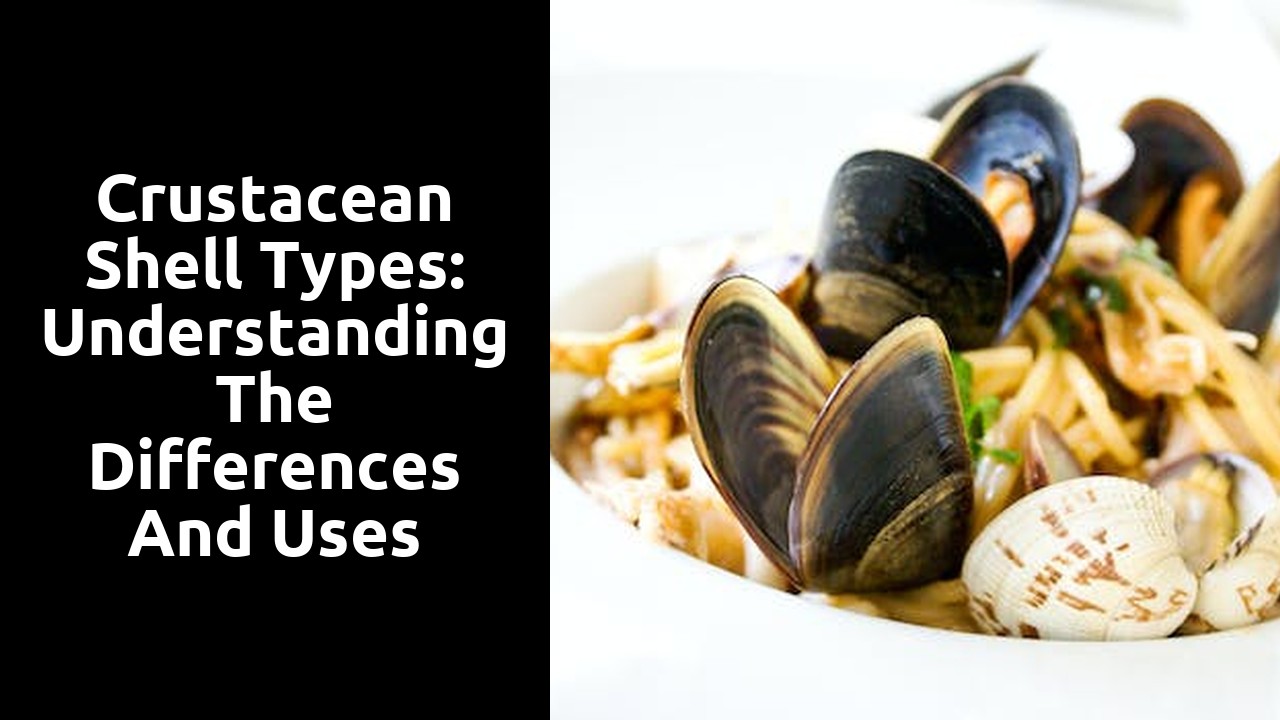Crustacean Shell Types: Understanding the Differences and Uses

Decoding the Varying Exoskeletons of Crustaceans
Crustaceans are fascinating creatures with a wide array of exoskeletons that serve as their protective armor. These exoskeletons, also known as shells, vary greatly in shape, size, and texture, reflecting the diverse lifestyles and habitats of these remarkable animals.
One of the most common types of crustacean shells is the calcified exoskeleton. This hard and rigid shell is composed primarily of calcium carbonate and provides excellent protection against predators. The calcified exoskeleton is typically found in crustaceans such as lobsters, crabs, and shrimp, which inhabit rocky or coral reef environments. Its sturdy structure allows these crustaceans to withstand the constant pressure and potential dangers of their surroundings.
Unraveling the Distinctive Armor of Crustaceans
Crustaceans, a fascinating group of arthropods, boast a wide array of exoskeletons that serve as their distinctive armor. These exoskeletons, also known as shells, are made up of a complex compound called chitin, which provides strength and protection to these remarkable creatures. However, not all crustaceans have the same type of exoskeleton, as their armor varies in shape, size, and texture.
One of the most common types of crustacean shell is the carapace. This hard, outer covering is typically found in crabs, lobsters, and shrimp, and acts as a shield to safeguard their delicate internal organs. Carapaces can range in thickness and may feature intricate patterns or spines, serving both as a form of defense against predators and as a means of camouflage in their surrounding environment. Additionally, the carapace also provides attachment points for muscles, enabling these crustaceans to move and flex with agility.
Exploring the Diverse Shells of Crustaceans
Crustaceans, belonging to the diverse and fascinating realm of marine life, possess an array of shells that vary in structure, texture, and composition. These shells serve not only as protective armor but also as a means of camouflage and communication. One of the most common types of crustacean shells is the carapace, a hard exoskeleton that covers the upper part of the body. The carapace is often rigid and durable, offering excellent protection against predators. It also acts as a shield for vital organs, ensuring the survival of the animal in its harsh marine environment.
Shedding Light on Crustacean Shell Varieties
Crustaceans, a diverse group of arthropods that include lobsters, crabs, and shrimp, have evolved a fascinating array of exoskeletons. These exoskeletons, commonly referred to as shells, are key to their survival in the harsh marine environments they inhabit. Shedding light on the various types of crustacean shells can help us understand the evolutionary adaptations and unique characteristics that enable these creatures to thrive.
One commonly recognized crustacean shell is the hard, calcified exoskeleton found in lobsters and crabs. This shell, made primarily of chitin and minerals like calcium carbonate, provides protection against predators and acts as a structural support system. Its rigid nature helps maintain the body shape and prevents collapse, allowing these creatures to navigate the ocean floor with ease. However, this type of exoskeleton also presents limitations, as it restricts growth and necessitates periodic molting to accommodate the growing body of the crustacean. As they outgrow their shells, crustaceans undergo a process called molting, where they shed their old shell and form a new, larger one to accommodate their increasing size. This natural shedding process is essential for their continued growth and survival.
Understanding the Unique Characteristics of Crustacean Exoskeletons
Crustaceans, a diverse group of arthropods that includes crabs, lobsters, and shrimp, boast an extraordinary feature: their exoskeletons. The exoskeletons of crustaceans play a crucial role in their survival, providing protection and support, as well as offering an attachment point for muscles. These exoskeletons, also known as shells, differ significantly from the internal skeletons of vertebrates. Composed of a tough, chitinous substance, crustacean shells are the epitome of strength and resilience. They serve as an outer suit of armor, safeguarding these creatures from predators and the harsh marine environment they inhabit.
The characteristics of crustacean exoskeletons are truly remarkable. One of their most distinctive traits is their ability to molt or shed their shells periodically as they grow. This molting process enables crustaceans to outgrow their constraining shells and replace them with larger, roomier versions. However, during the molting period, the crustaceans are temporarily vulnerable and susceptible to predation. The new shell takes time to harden, leaving the crustacean exposed and defenseless until the process is complete. Nevertheless, this vulnerability is a small price to pay for the crustacean's continued growth and adaptation to its changing environment. The unique characteristic of molting makes crustaceans constantly evolving and adapting creatures, capable of withstanding the dynamic challenges of their habitats.
Delving into the Multifaceted Shells of Crustaceans
Crustaceans, with their wide range of species and diverse habitats, exhibit an intriguing assortment of shell types. These exoskeletons, consisting of chitin and minerals, serve as a protective covering for these remarkable creatures. One of the most common shell varieties found among crustaceans is the carapace. This hard, calcified structure covers the cephalothorax, providing stability and defense against predators. The carapace can be smooth or adorned with ridges and spines, depending on the species, and may even have specialized extensions for burrowing or camouflage. With such variability in carapace features, it is clear that its form relates closely to the survival strategies of individual crustaceans.
Related Links
Crayfish: Freshwater Crustaceans for Perfect Bisques and BoilsLobster: The King of Crustaceans
Barnacles: The Lesser-Known Delicacy from the Sea
Krill: Tiny Crustaceans with a Huge Impact
Prawns: Versatile Crustaceans for Your Culinary Adventures
Langoustine: The Petite Crustacean with Big Flavor
Crawfish: A Southern Delicacy
Crab: From Blue to Dungeness A Guide to Crustacean Delights